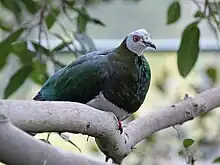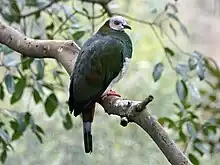| White-bellied imperial pigeon | |
|---|---|
 | |
| At San Diego Zoo | |
| Scientific classification | |
| Domain: | Eukaryota |
| Kingdom: | Animalia |
| Phylum: | Chordata |
| Class: | Aves |
| Order: | Columbiformes |
| Family: | Columbidae |
| Genus: | Ducula |
| Species: | D. forsteni |
| Binomial name | |
| Ducula forsteni (Bonaparte, 1854) | |
| Synonyms[2] | |
The white-bellied imperial pigeon (Ducula forsteni) is a species of bird in the pigeon family Columbidae. First described by the French ornithologist Charles Lucien Bonaparte in 1854, it is endemic to Indonesia, where it is found on Sulawesi, Buton, Taliabu, Togian, and Peleng. It inhabits primary forest, dense secondary forest, and isolated areas of hill forest. A large pigeon with a long tail, it measures 42.5–51.5 cm (16.7–20.3 in) long and weighs 510 g (18 oz) on average. Males are mainly green, with pale-grey heads and bellies, chestnut vents, and a pale grey tail band, along with a red orbital ring. Females are nearly identical, but have darker grey areas in their plumage.
The white-bellied imperial pigeon feeds on fruit. It is listed as being of least concern by the International Union for Conservation of Nature (IUCN) on the IUCN Red List due to its sufficiently large range and lack of significant population decline. However, its population is declining due to habitat destruction.
Taxonomy and systematics
The white-bellied imperial pigeon originally described as Hemiphaga forsteni by the French ornithologist Charles Lucien Bonaparte in 1854.[3] It was then moved to the now-defunct genus Carpophaga in 1856 by the British zoologist George Robert Gray.[4] Carpophaga was later lumped with Ducula.[5] The generic name Ducula is from dukul, the Nepali name for imperial pigeons. The specific name forsteni is in honour of Eltio Forsten, a Dutch zoologist and collector who worked in the East Indies.[6] White-bellied imperial pigeon is the official common name designated by the International Ornithologists' Union.[7] Other common names for the species include Celebes imperial pigeon, emerald imperial pigeon, Forster's imperial pigeon, green-and-white zone-tailed pigeon, green-and-white imperial pigeon, white-bellied imperial pigeon, Celebes zone-tailed imperial pigeon, and Celebes large zone-tailed pigeon.[8][9]
The white-bellied imperial pigeon is one of 41 species in the imperial pigeon genus Ducula, members of which are found from southern Asia to New Guinea, Australia, and the Pacific Islands. The species is closely related to the pink-bellied imperial pigeon, with which it is occasionally considered conspecific. These two species form a species group with the Mindoro and grey-headed imperial pigeons. All four of these species have sometimes been split into their own genus, Zonophaps. This group may also form a link between the imperial pigeons and the Ptilinopus fruit doves. It is currently monotypic, but the population on the Sula Islands may be a distinct subspecies.[9][10]
Description

The white-bellied imperial pigeon is a very large, boldly marked pigeon with a long tail, measuring 42.5–51.5 cm (16.7–20.3 in) long and weighing 510 g (18 oz) on average. Its upperparts and breast are mainly dark green, with bronze-red glossing, especially on the mantle. The head is pale grey, becoming white on the forehead and throat, while the breast and belly are white with a pink or cream tinge. The undertail coverts are dark chestnut, while the outside of the tail has a pale grey band across the centre. The iris is yellow or orange with a darker red or orange orbital ring. Its bill is black, with feathering on the top of the cere, and the feet are purplish. Females are nearly identical to males, but have darker grey in the plumage.[9][10]
The white-bellied imperial pigeon may be confused with the grey-headed imperial pigeon, but the latter species is smaller, has a narrower and darker tail band, and more uniform grey upperparts and head. It also lacks green on the breast and white on the belly, along with having greenish instead of red orbital skin. The green imperial pigeon may also be confused with the white-bellied imperial pigeon, but has wine-grey head, neck, breast and abdomen, chestnut on the nape, and lacks a tail band.[9]
Vocalisations
The white-bellied imperial pigeon's advertising call is a short, low-pitched whuu-whooo....whuu-whooo. Both notes are 0.2–0.3 seconds long, and the second is lower-pitched and more emphasized than the first. A three-note variation has also been recorded, in which the third note is the same as the second note.[10] It mainly vocalises before dawn and after mid-day.[9]
Distribution and habitat
The white-bellied imperial pigeon is endemic to Indonesia, where it is found on Sulawasi, Buton, Taliabu, Togian, and Peleng. It inhabits primary forest and dense secondary forest in mountains or along the coast, along with isolated areas of hill forest. It is found at elevations of 150–2,200 m (490–7,220 ft), but is most common at elevations of 800–1,600 m (2,600–5,200 ft).[10]
Behaviour and ecology
The white-bellied imperial pigeon is mostly seen singly or in pairs, but also in small flocks near fruit trees. It is most easily seen while flying over the canopy, high in tall trees, or in smaller trees along forest edges. Its flight is heavy, with deep and slow wingbeats.[9]
Diet
The white-bellied imperial pigeon feeds exclusively on fruit. Flocks of up to 30 birds can form at fruiting trees, especially figs.[10]
Status
The white-bellied imperial pigeon is listed as being of least concern by the International Union for Conservation of Nature (IUCN) on the IUCN Red List due to its sufficiently large range and lack of significant population decline. However, its population is thought to be declining due to habitat loss.[1] It is moderately common overall on Sulawesi, being locally common in some areas, and uncommon on Taliabu.[10]
References
- 1 2 BirdLife International (2018). "Ducula forsteni". IUCN Red List of Threatened Species. 2018: e.T22691617A130179330. doi:10.2305/IUCN.UK.2018-2.RLTS.T22691617A130179330.en. Retrieved 13 November 2021.
- ↑ "Ducula forsteni (White-bellied Imperial-Pigeon)". Avibase. Retrieved 2021-11-22.
- ↑ Académie des sciences; Bonaparte, Charles Lucien (1854). Comptes rendus hebdomadaires des séances de l'Académie des sciences (in French). Vol. 39. Paris: Centre national de la recherche scientifique. p. 1077.
- ↑ British Museum of Natural History (1893). Catalogue of the Birds in the British Museum. Vol. 21. London. p. 208.
{{cite book}}: CS1 maint: location missing publisher (link) - ↑ Cottrell, G. William; Greenway, James C.; Mayr, Ernst; Paynter, Raymond A.; Peters, James Lee; Traylor, Melvin A.; University, Harvard (1937). Check-list of birds of the world. Vol. 3. Cambridge: Harvard University Press. pp. 42–43.
- ↑ Jobling, James A. (2010). Helm Dictionary of Scientific Bird Names. London: Christopher Helm. pp. 141, 163. ISBN 978-1-4081-2501-4.
- ↑ "Pigeons – IOC World Bird List". Retrieved 2021-11-15.
- ↑ "Ducula forsteni (White-bellied Imperial-Pigeon)". Avibase. Retrieved 2021-11-22.
- 1 2 3 4 5 6 Gibbs, David; Barnes, Eustace; Cox, John (2001). Pigeons and Doves: A Guide to the Pigeons and Doves of the World. Pica Press. pp. 526, 528–529. ISBN 978-1-8734-0360-0. OCLC 701718514.
- 1 2 3 4 5 6 Baptista, Luis F.; Trail, Pepper W.; Horblit, H.M.; Boesman, Peter F. D.; Garcia, Ernest (2020-03-04). Billerman, Shawn M.; Keeney, Brooke K.; Rodewald, Paul G.; Schulenberg, Thomas S. (eds.). "White-bellied Imperial-Pigeon (Ducula forsteni)". Birds of the World. Cornell Lab of Ornithology. doi:10.2173/bow.wbipig1.01. S2CID 242225452. Retrieved 2021-11-22.
